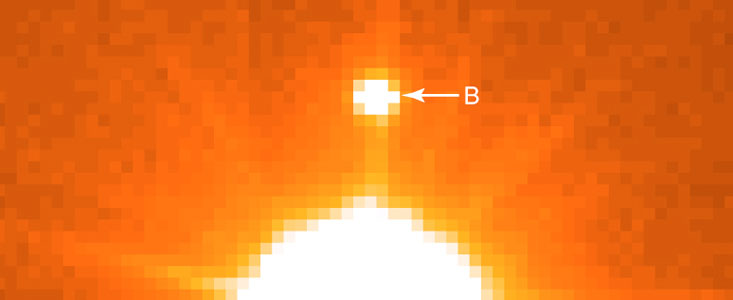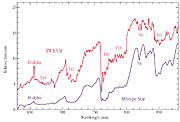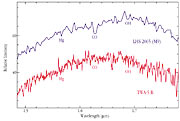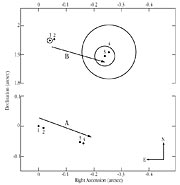Communiqué de presse
Youngest Brown Dwarf Yet in a Multiple Stellar System
... and the Sharpest Optical Image (0.18 arcsec) from the VLT so far...!
21 juillet 2000
Astronomers are eager to better understand the formation of stars and planets - with an eye on the complex processes that lead to the emergence of our own solar system some 4600 million years ago. Brown Dwarfs (BDs) play a special role in this context. Within the cosmic zoo, they represent a class of "intermediate" objects. While they are smaller than normal stars, they shine by their own energy for a limited time, in contrast to planets. Recent observations with the ESO Very Large Telescope (VLT) of a "young" Brown Dwarf in a multiple stellar system are taking on a particular importance in this connection. An evaluation of the new data by an international team of astronomers [1] shows that it is by far the youngest of only four such objects found in a stellar system so far. The results are now providing new insights into the stellar formation process.
This small object is known as TWA-5 B and with a mass of only 15 - 40 times that of Jupiter, it is near the borderline between planets and Brown Dwarfs, cf. the explanatory Appendix to this Press Release. However, visible and infrared VLT spectra unambiguously classify it in the latter category. Accurate positional measurements with the Hubble Space Telescope (HST) and the VLT hint that it is orbiting the central, much heavier and brighter star in this system, TWA-5 A (itself a close double star of which each component presumably has a mass of 0.75 solar masses), with a period that may be as long as 900 years.
And, by the way, an (I-band) image of the TWA-5 system is the sharpest delivered by the VLT so far, with an image size of only 0.18 arcsec [2]!
Brown Dwarfs: a cool subject
In current astronomical terminology, Brown Dwarfs (BDs) are objects whose masses are below those of normal stars - the borderline is believed to be about 8% of the mass of our Sun - but larger than those of planets, cf. [3]. Unlike normal stars, Brown Dwarfs are unable to sustain stable nuclear fusion of hydrogen. Once they have been formed, they enter into a very long phase of slow contraction. This process releases (potential) energy that is emitted in the form of electromagnetic radiation. Their brightness decreases with time, as they become smaller and smaller and their energy reservoir dwindles.
A few dozen "free-floating", isolated Brown Dwarfs have been discovered so far in space. They include members of the well-known, comparatively young Pleiades cluster (120 million years old) and some much older ones (some thousands of million years) only a few light-years away. A typical example is Kelu-1 that was found at ESO in 1997, see ESO Press Release eso9709.
However, despite extensive searches and much invested effort, astronomers have so far only found three Brown Dwarfs that have been confirmed as companions to normal stars: Gl 229 B, G196-3 B, and Gl 570 D.
The younger a Brown Dwarf is, the more luminous it is, and the nearer it is to us, the brighter it appears in the sky. Old Brown Dwarfs are intrinsically so faint that, with the currently available instruments, they can only be found if they are nearby. It is therefore no surprise that the known, nearby Brown Dwarfs are generally older than the more distant ones, e.g. those found in the Pleiades.
A programme to find young Brown Dwarfs
It is on this background, that the international astronomer team [1] is now searching for young Brown Dwarfs that are companions to young, nearby stars.
However, young stars are quite rare in the solar neighbourhood. Only a few were known before the very successful ROSAT X-ray survey that discovered about 100 young and nearby stars, less than 100 million years old and within ~ 300 light-years distance. The new research programme attempts to find brown dwarf companions to these and other young and nearby stars.
For this, state-of-the-art infrared imaging cameras are used at the 3.6-m New Technology Telescope (NTT) with the SOFI (and SHARP) instrument on La Silla, as well as the 8.2-m VLT/ANTU telescope with the ISAAC multi-mode instrument at Paranal.
The first step is to take high-resolution images of the stars from the ROSAT list to look for possible faint companions. However, any faint object found near one of the programme stars may of course be a completely unrelated fore- or background object and it is therefore imperative to check this by means of supplementary observations.
Two methods are available. The first implies taking spectra of the companion candidates that demonstrate whether they are bona-fide Brown Dwarfs that display spectral lines typical for the cool atmospheres of this class, e.g., of Titanium Oxide (TiO) and Vanadium Oxide (VO). Infrared spectra are particularly useful for a measurement of the atmospheric temperature.
The other involves obtaining a second image some years later. If the companion candidate and the brighter star belong to the same stellar system, they must move together on the sky or, as astronomers say, their measured "proper motions" must be (nearly) the same.
If both checks are positive, the fainter object is most likely to be a bona-fide Brown Dwarf companion to the young and nearby star. To be absolutely certain, its orbital motion should also be detected, but it will be very slow and can only be perceived after several years of continued observations.
VLT observations of TWA-5 B
Two years ago, a faint companion candidate was found near one of the young and nearby stars included in the present programme and designated TWA-5 (also known as CoD -33 7795). It is about 12 million years old and is a member of a group of about a dozen young stars (of the "T Tauri"-type), seen in the southern constellation Hydra (the Water-Snake) and grouped around the star TW Hya, the first to be found in this area ("TWA" means the "TW Hya Association"). The HIPPARCOS mission of the European Space Agency (ESA) measured a mean distance to some of these stars of ~ 180 light-years (55 parsec).
This faint companion ("TWA-5 B") was first detected in 1998 with the Hubble Space Telescope (HST), but until now, no spectrum had been published, nor had the proper motion been measured. It is indeed a difficult object to observe: it is 100 times fainter than the bright star and is located only two arcsec away in the sky.
In order to investigate the nature of this object, the team obtained images and spectra with the Very Large Telescope (VLT) at Paranal.
An optical image was taken by ESO staff on 21 February 2000 during a technical test period ([4]) with the FORS-2 (FOcal Reducer/low dispersion Spectrograph) at the 8.2-m VLT/KUEYEN telescope. This is actually the sharpest optical image so far taken with the VLT, with a FWHM (full-width-at-half-maximum) of only 0.18 arcsec [2] and it shows the images of the primary star ("TWA-5 A") and the 100 times fainter companion ("TWA-5 B") very well separated.
An infrared image was taken on 16 April 2000 with the ISAAC (Infrared Spectrograph and Array Camera) multi-mode instrument at the 8.2-m VLT/ANTU telescope. This image was obtained by ESO staff in service mode and again, TWA-5 A and B are both clearly seen.
More recently, spectra of TWA-5 B were taken with FORS-2 (optical wavelength region) and ISAAC (infrared). These observations were particularly difficult, because of the need to avoid contamination from the strong light of the much brighter object, only 2 arcsec away.
The nature of TWA-5 B
The optical spectrum of TWA-5 B shows strong molecular absorption features typical for very cold stellar atmospheres and confirming it as a Brown Dwarf. Both the optical and the infrared (ESO Press Photo eso0023) spectra indicate a late spectral type (about M9) of TWA-5 B that corresponds to an atmospheric temperature of "only" ~2200 °C (2500 K). For comparison, that of the Sun is ~ 6000 °C.
The hydrogen (H-alpha) emission line indicates strong activity in the upper atmospheric layers (the chromosphere), as normally found in young stars and young Brown Dwarfs. Moreover, the comparatively weak sodium (Na) absorption line shows that this object must be relatively large for its low mass, and that it is still in the early stage of contraction.
These are clear signs of young age and fully consistent with TWA-5 B being a bona-fide companion to the young star TWA-5 A . In fact, the possibility that an object as cold as TWA-5 B is located within 2 arcsec from TWA-5 A by chance is less than 10 -8.
The motion of TWA-5 B
When comparing the HST positional observations from 1998 and those with the VLT in 2000 (ESO Press Photo eso0023), it is obvious that TWA-5 A and TWA-5 B move with very nearly the same speed and in the same direction on the sky.
There is therefore no doubt that the two objects are physically connected within a stellar multiple system. At the distance of about 180 light-years, the angular separation (2 arcsec) corresponds to a projected distance of 110 AU (about 2.75 times the mean distance between the Sun and the outermost planet in the solar system, Pluto). From this and the mass of TWA-5 A, it is possible to conclude that one full orbit of TWA-5 B around TWA-5 A will last about 900 years.
Mass, temperature and age of TWA-5
From the measured optical and infrared brightness of TWA-5 B and the known distance, it is found to be about 400 times fainter than our Sun. Together with the measured temperature, about 2200 °C, and based on theoretical models of Brown Dwarfs, a mass of about 15 to 40 Jupiter masses is deduced. It is also possible to estimate its age; it is found to be very similar as that of TWA-5 A (12 million years), further supporting the conclusion that they were formed at the same time and belong to the same stellar system.
TWA-5 B is only the fourth Brown Dwarf so far confirmed as a companion to a normal star, both by spectroscopic and proper motion measurements. It is unique among these by being by far the youngest (12 million years). The others are much older; one is nearly 300 million years old and the other two are several thousand million years old.
Indeed, TWA-5 A and its Brown Dwarf companion TWA-5 B are still in the process of formation . The system is the only one so far discovered at this early evolutionary stage. These new findings thus have a direct bearing on the question how Brown Dwarfs form as companions to normal stars.
The next steps
More detailed investigations of this unique object are now planned. They will include an attempt to detect absorption lines of other elements that are typical for brown dwarfs (especially of lithium) by means of higher-resolution spectra, as well as further imaging that may lead to a detection of the orbital motion within a few years.
The team is also actively searching for other very low-mass companions in order to cast more light on some of the fundamental questions, e.g.: What is the mass range of Brown Dwarfs? What are their orbital characteristics? Can stars of all masses have Brown Dwarf companions? Are the distributions of the masses of isolated and companion brown dwarfs similar or different?
Not less exciting, the same observational method can also be used to search for companions of even lower mass, in particular planets. Until now, no extra-solar planets have been detected directly, but only indirectly by other methods, c.f. ESO Press Release eso0019.
For this, "deep" images of young nearby stars and their immediate surroundings must be obtained. Young planets are also still relatively hot and, hence, relatively bright, but they are many times fainter than TWA-5 B, hence the need for long exposures.
However, such observations are extremely difficult, as any planet - even a young and relatively massive and bright one - will be much fainter than the star around which it revolves and is located very close to it in the sky.
One observational method that helps overcome this fundamental obstacle is already used by the team. It consists of taking a very large number (hundreds or even thousands) of very short exposures (1 second or less) and then to add them up using computers (the "speckle method") and suppressing the image blur caused by atmospheric turbulence. In this way, even very faint companions may be detected near bright stars. This will work even better with adaptive optics, e.g. with the CONICA-NAOS instrument that will soon be installed at the third VLT Unit Telescope, MELIPAL.
When will the first image of an exoplanet be obtained?
This kind of research is very exciting, but also demands great care. A recent event illustrates this.
Just a few months ago, the present astronomer team detected a companion candidate to another young star on their list (TWA-7). This object was 100,000 times fainter than and only 2.5 arcsec away from TWA-7. If it were a true companion orbiting TWA-7, its mass would have been only 3 Jupiter masses (as deduced from the observed brightness) and it would thus very likely have been a true exoplanet. However, an infrared spectrum subsequently taken with the ISAAC instrument at VLT/ANTU showed that it was in fact a background star, located almost 10,000 light-years farther away than TWA-7!
Despite the negative result, those observations clearly showed that direct detection and subsequent, effective spectroscopic verification of extra-solar planets is now quite feasible with a ground-based facility like the VLT.
It is thus not a very daring prediction that the ongoing searches may soon lead to the first direct images of an extra-solar planet. These are indeed exciting times!
Notes
[1] The team consists of Ralph Neuhaeuser (Principal Investigator) and Nuria Huelamo (both Max-Planck-Institut für Extraterrestrische Physik, Garching, Germany), Eike Guenther (Landessternwarte Tautenburg, Germany), Monika Petr (Max-Planck-Institut für Radioastronomie, Bonn, Germany), Wolfgang Brandner (Institute for Astronomy, Honolulu, Hawaii, USA) and João Alves (ESO, Garching, Germany).
[2] The hitherto sharpest image (0.25 arcsec) was obtained in March 1999, c.f. ESO PR 06/99. It was obtained during a period of exceptionally good "seeing" (low level of atmospheric turbulence). The installation of adaptive optics at the VLT, foreseen in 2001, will provide a means to overcome the image smearing effect of air turbulence and hence, consistently obtain stellar images of a few hundredths of an arcsecond diameter, near the theoretical limit for an 8.2-m telescope (the telescope diffraction limit ).
[3] 1 solar mass = 2 x 10^30 kg. 1 Jupiter mass = 2 x 10^27 kg ~ 0.001 solar mass. Thus, the "BD-limit" of 0.08 solar masses corresponds to ~ 80 Jupiter masses.
[4] This CCD frame was taken by Paranal Observatory staff during the one of the KUEYEN/FORS-2 "dry runs" in a "technical period", i.e. test observations that served to practise and perfect the operation of the telescope and instrument, before it was made available to the community on April 1, 2000. These and many similar data from this period were quickly released to the community and are available in the publicly accessible area of the VLT Data Archive.
Plus d'informations
The work described in this Press Release is discussed by the team in a research article that has been accepted for publication in the European journal Astronomy & Astrophysics.
Another paper ("Direct imaging search for planetary companions next to young nearby stars") is also available with more details about the current searches, including the spectrum of the background star at TWA-7.
Appendix: Planets and Brown Dwarfs
Planets and Brown Dwarfs mainly differ by the way they form. While it is believed that Brown Dwarfs (both as companions to normal stars and as isolated objects) form as do normal low-mass stars by fragmentation and subsequent contraction in interstellar gas clouds, planets form in circumstellar gas- and dust disks around their central star.
However, an exact dividing line in terms of mass cannot yet be drawn between planets and brown dwarfs, neither from theory nor from observation. It appears that the lower mass limit for Brown Dwarfs is around 0.01 solar masses (about 10 Jupiter masses) and that the upper mass limit for planets is also near this value. Further observations and theoretical progress are needed to clarify this question.
Below this mass limit (~ 0.01 solar masses), an object cannot burn the hydrogen isotope deuterium. Planets will therefore have more deuterium in their atmospheres than Brown Dwarfs. One way to distinguish observationally between a planet and a Brown Dwarf is therefore to search for absorption lines of deuterium in the spectrum of the object. These lines would be much stronger in a planet than in a Brown Dwarf.
However, such observations would require very high spectral resolution in the infrared region. At this moment, no corresponding observational facilities exist, but it will most probably be possible with the VLT High-Resolution IR Echelle Spectrometer (CRIRES), currently under development for installation at VLT/ANTU in 2003.
The dividing line between real stars on one side and Brown Dwarfs and planets on the other side is better known. Any object that weighs less than ~ 0.08 solar masses cannot sustain stable fusion of hydrogen and also cannot burn the light element lithium.
Contacts
Ralph Neuhaeuser
Max-Planck-Institut für Extraterrestrische Physik
Garching, Germany
Tél: +49-89-32993398
Courriel: rne@mpe.mpg.de
A propos du communiqué de presse
| Communiqué de presse N°: | eso0023 |
| Legacy ID: | PR 16/00 |
| Nom: | Spectrum, TWA-5 A, TWA-5 B |
| Type: | Milky Way : Star Milky Way : Star : Type : Brown Dwarf |
| Facility: | Very Large Telescope |
| Instruments: | ISAAC |
| Science data: | 2000A&A...360L..39N |
Our use of Cookies
We use cookies that are essential for accessing our websites and using our services. We also use cookies to analyse, measure and improve our websites’ performance, to enable content sharing via social media and to display media content hosted on third-party platforms.
ESO Cookies Policy
The European Organisation for Astronomical Research in the Southern Hemisphere (ESO) is the pre-eminent intergovernmental science and technology organisation in astronomy. It carries out an ambitious programme focused on the design, construction and operation of powerful ground-based observing facilities for astronomy.
This Cookies Policy is intended to provide clarity by outlining the cookies used on the ESO public websites, their functions, the options you have for controlling them, and the ways you can contact us for additional details.
What are cookies?
Cookies are small pieces of data stored on your device by websites you visit. They serve various purposes, such as remembering login credentials and preferences and enhance your browsing experience.
Categories of cookies we use
Essential cookies (always active): These cookies are strictly necessary for the proper functioning of our website. Without these cookies, the website cannot operate correctly, and certain services, such as logging in or accessing secure areas, may not be available; because they are essential for the website’s operation, they cannot be disabled.
Functional Cookies: These cookies enhance your browsing experience by enabling additional features and personalization, such as remembering your preferences and settings. While not strictly necessary for the website to function, they improve usability and convenience; these cookies are only placed if you provide your consent.
Analytics cookies: These cookies collect information about how visitors interact with our website, such as which pages are visited most often and how users navigate the site. This data helps us improve website performance, optimize content, and enhance the user experience; these cookies are only placed if you provide your consent. We use the following analytics cookies.
Matomo Cookies:
This website uses Matomo (formerly Piwik), an open source software which enables the statistical analysis of website visits. Matomo uses cookies (text files) which are saved on your computer and which allow us to analyze how you use our website. The website user information generated by the cookies will only be saved on the servers of our IT Department. We use this information to analyze www.eso.org visits and to prepare reports on website activities. These data will not be disclosed to third parties.
On behalf of ESO, Matomo will use this information for the purpose of evaluating your use of the website, compiling reports on website activity and providing other services relating to website activity and internet usage.
Matomo cookies settings:
Additional Third-party cookies on ESO websites: some of our pages display content from external providers, e.g. YouTube.
Such third-party services are outside of ESO control and may, at any time, change their terms of service, use of cookies, etc.
YouTube: Some videos on the ESO website are embedded from ESO’s official YouTube channel. We have enabled YouTube’s privacy-enhanced mode, meaning that no cookies are set unless the user actively clicks on the video to play it. Additionally, in this mode, YouTube does not store any personally identifiable cookie data for embedded video playbacks. For more details, please refer to YouTube’s embedding videos information page.
Cookies can also be classified based on the following elements.
Regarding the domain, there are:
- First-party cookies, set by the website you are currently visiting. They are stored by the same domain that you are browsing and are used to enhance your experience on that site;
- Third-party cookies, set by a domain other than the one you are currently visiting.
As for their duration, cookies can be:
- Browser-session cookies, which are deleted when the user closes the browser;
- Stored cookies, which stay on the user's device for a predetermined period of time.
How to manage cookies
Cookie settings: You can modify your cookie choices for the ESO webpages at any time by clicking on the link Cookie settings at the bottom of any page.
In your browser: If you wish to delete cookies or instruct your browser to delete or block cookies by default, please visit the help pages of your browser:
Please be aware that if you delete or decline cookies, certain functionalities of our website may be not be available and your browsing experience may be affected.
You can set most browsers to prevent any cookies being placed on your device, but you may then have to manually adjust some preferences every time you visit a site/page. And some services and functionalities may not work properly at all (e.g. profile logging-in, shop check out).
Updates to the ESO Cookies Policy
The ESO Cookies Policy may be subject to future updates, which will be made available on this page.
Additional information
For any queries related to cookies, please contact: pdprATesoDOTorg.
As ESO public webpages are managed by our Department of Communication, your questions will be dealt with the support of the said Department.




